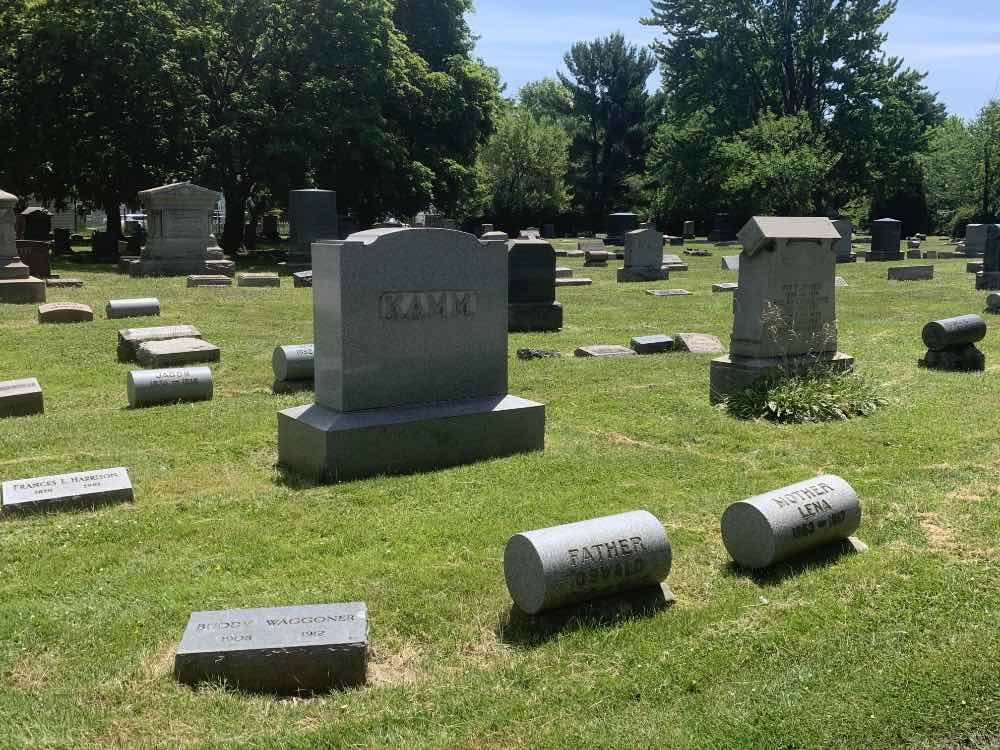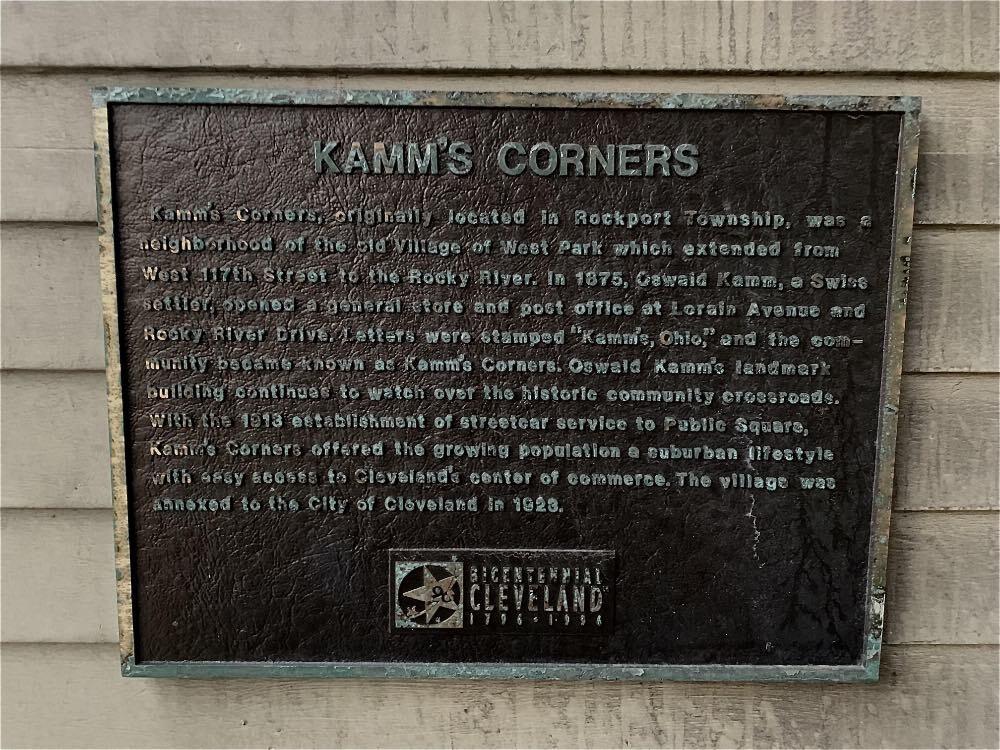
Oswald Kamm ran a popular grocery store and post office, at the main intersection of what is today known as “Kamm’s Corners.” He was an influential and popular figure in the early history of West Park, with a lasting legacy that has carried his namesake throughout generations, though few know his entire story.
Standing at the southwest corner of Rocky River Drive and Lorain Avenue (previously Lorain Street), the Kamm Building has been the centerpiece of Kamm's Corners for more than a century. Originally built in 1900 for Oswald Kamm’s lucrative general store and later used as a post office, it has been home to many businesses, mostly restaurants, during its time. In the past few years, the Kamm Building has become vacant and is struggling to find a permanent use. Its recognition is important, for Kamm served as a popular town figure and played a role in the development of the Kamm’s Corners neighborhood in West Park.
Oswald Kamm was a Swiss immigrant who came to the United States sometime in the mid-nineteenth century, and in 1875 he settled on buying a four-acre property at the corner of Lorain Street and Rocky River Drive. Previously a grocery clerk in the Clark-Fulton area on the west side, Kamm set up a grocery store at this corner. In 1900, the current structure that stands today had been built and the old store razed. It’s likely that Kamm and his family used the second floor of the new store as their living quarters for some period of time. According to a 1962 Plain Dealer article, Kamm was approached by township officials to become an official post clerk during President Grover Cleveland’s administration. This new venture required Kamm to wake up at four or five every morning and walk to the Nickel Plate Road rail station (in present-day Rocky River) to pick up the mail and return to his store by 6 A.M. This eventually led to the coincidental naming of “Kamm's Corners” which has since become one of four neighborhoods within West Park. Numerous old plat maps refer to the southwest corner of Rocky River Drive and Lorain Street as “Kamm’s Ohio”, and it was written on any mail expected to go to Kamm’s post office.
The area Oswald Kamm and his wife Louise, who went by Lena (nee Klane), would call home for nearly four decades changed rapidly during their time. When Kamm arrived at what would’ve been considered part of “Rockport Township,” it was little more than farmland and a few stately homes. As Lakewood, Rocky River, and Goldwood (Fairview Park) split from Rockport Township and formed as villages and eventually cities, West Park also became an independent village of about 12.5 square miles. There were several name changes to the area during Kamm’s life: Rockport Hamlet, West Park Township, the Village of West Park, and eventually the city of West Park in 1921.
In the early 1900s, when West Park gained rail service, Kamm’s post office became an interurban stop of the Cleveland, Southwestern, and Columbus Railway Co. (CS&C), which was “the second largest operator of interurban railways in Ohio at the time.” In the early 20th century, streetcars and rail lines were a main source of public transportation. Kamm’s stop linked to nearby Puritas Springs Park and ran south toward Berea. CS&C eventually discontinued operations in 1931 due to stock market failure, unprofitable lines, and growing automobile ownership. In 1913, A streetcar known as the “Cleveland Green Line” ran west on Lorain Avenue from Public Square and stopped at Kamm’s Corners. These rail lines shaped the early development of the West Park area. By the 1920s, subdivisions and commercial development had significantly increased in West Park. Kamm’s stop played a major role in the commercialization of Kamm’s Corners. He was a well-known businessman and postal clerk amongst community members and farmers from surrounding areas. Despite Kamm’s role, little was written about him while he was alive.
By the early 1900s, a three-story home to the west of his store faced Lorain Street, though the exact build year is unknown. Kamm’s house was moved in 1925 to 17134 Fernshaw Avenue, directly behind where it stood before. It stands today as a private residence. In 1909, Kamm constructed a rowhouse-style apartment building known as “Kamm’s Terrace” at 3890 Rocky River Drive, which still exists as an office building. Kamm’s daughter Lena and her husband Fred A. Colbrunn, great-grandson of the largest landowning family in the village, lived in a smaller home directly to the north of Kamm’s Terrace, and the couple owned the apartment building until the 1950s. The Colbrunn family owned the Rockport Racing Track at the northeast corner of Lorain and Rocky River Drive and were local contractors and businessmen. The Kamm and Colbrunn families were close in business, and it is possible they assisted Kamm in the construction of his buildings. Both families were involved in the Lorain Greenhouse Co., one of many greenhouses at the time in the former Rockport area. Despite this connection, it appears there is no known architect for any of Kamm’s buildings.
Oswald and Lena Kamm raised their family in West Park, and had four children: Jacob, Fred, Lena, and Dora. Sadly, Oswald outlived all but one of his children. When his wife Lena passed away in 1917, the village of West Park had a variety of businesses and around 8,000 residents. One year later, Oswald’s eldest son Jacob (born in 1874) died from a murder-suicide, committed by an uncle after a dispute. The crime occurred at a home owned by the uncle further north on Rocky River Drive. Kamm himself died on November 17, 1922, ten days after the city of West Park voted yes on a proposition to be annexed into the city of Cleveland. Overwhelmingly, “The residents of West Park had chosen to become Clevelanders, largely due to promises of five-cent fares and extended streetcar services.”
After Oswald Kamm’s death, his surviving daughter and various relatives, including Colbrunn family members, split up the properties that Kamm had owned. Kamm’s store was converted to a lunch hall and candy store referred to as “Rockport Kelly’s.” A son of a local politician is said to have run the shop. During the early 1940s, it was home to Benders Cafe, a dance hall that was short-lived. After this, it became perhaps what most West Parkers know it as—Tony’s Spaghetti House, and later Tony’s Restaurant (operating under different ownership). It lasted just over 50 years before a fire destroyed the interior of the building in the 1990s. Kamm's Corners Development Corporation (now West Park-Kamm’s Neighborhood Development) and a local architect teamed up to restore it in 1997. Renovations included new windows that were previously blocked up, and an exterior color scheme that matched the original. An addition was made to the back side of the building, allowing for a large bar and outdoor patio to be installed. After the renovation, the building housed Alfonso’s Tuscan Grill for just over 10 years, and later became Panini’s Bar and Grill. When Panini’s closed, it sat vacant for around two years. Ironwood Cafe began operating out of the building in 2015. They eventually changed the name to Kamm’s Cafe, honoring the Kamm name once again. However, Kamm’s Cafe closed within a year of the name change, and the building has been vacant since.
The future of the Kamm Building may still be bright, but it has yet to be reinvigorated as the gem of the community that it once was. It is under no imminent threat but faces the challenge of being a large commercial space in a tough market. Perhaps the neighborhood can come together and work with city leaders, community officials, and the owners to ensure this historic building is properly recognized locally as well as nationally. Past efforts to preserve the building have proven successful and it can once again serve as a beneficial landmark to the neighborhood of West Park.
Images














